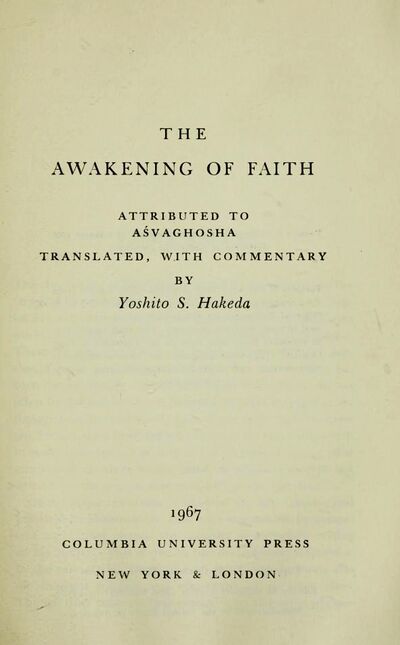The Awakening of Faith (1967)
< Books
| (10 intermediate revisions by the same user not shown) | |||
| Line 1: | Line 1: | ||
{{Book | {{Book | ||
| − | |||
| − | |||
| − | |||
| − | |||
| − | |||
| − | |||
| − | |||
|FullTextRead=No | |FullTextRead=No | ||
| − | |BookToc=Foreword, by Wm. Theodore de Bary | + | |BookToc=**{{i|Foreword, by ''Wm. Theodore de Bary''|v}} |
| − | Preface | + | **{{i|Preface|vii}} |
| − | Introduction 1 | + | **{{i|Introduction|1}} |
| − | |||
| − | |||
| − | |||
| − | |||
| − | |||
| − | |||
| − | |||
| − | |||
| − | |||
| − | |||
| − | |||
| − | |||
| − | |||
| − | |||
| − | + | *{{i| ''The Awakening of Faith''|21}} | |
| − | |||
| − | |||
| − | |||
| − | |||
| − | |||
| − | |||
| − | |||
| − | |||
| − | |||
| − | |||
| − | |||
| − | |||
| − | |||
| − | |||
| − | |||
| − | |||
| − | |||
| − | |||
| − | |||
| − | |||
| − | |||
| − | |||
| − | |||
| − | |||
| − | |||
| − | |||
| − | + | **{{i|Invocation|23}} | |
| − | The | + | **{{i|The Contents of the Discourse|24}} |
| − | A. The | + | *{{i|Part 1 The Reasons for Writing|25}} |
| − | + | *{{i|Part 2 Outline|28}} | |
| − | + | *{{i|Part 3 Interpretation|31}} | |
| − | + | **{{i|Chapter One: Revelation of True Meaning|31}} | |
| − | + | ***{{i|I. One Mind and Its Two Aspects|31}} | |
| − | + | ****{{i|A. The Mind in Terms of the Absolute|32}} | |
| − | + | *****{{i|1. Truly Empty|34}} | |
| − | + | *****{{i|2. Truly Nonempty|35}} | |
| − | + | ****{{i|B. The Mind in Terms of Phenomena|36}} | |
| − | + | *****{{i|1. The Storehouse Consciousness|36}} | |
| − | + | ******{{i|a. The Aspect of Enlightenment|37}} | |
| − | of | + | *******{{i|(1) Original Enlightenment|37}} |
| − | + | *******{{i|(2) The Process of Actualization of Enlightenment|38}} | |
| − | + | ********{{i|(a) Purity of Wisdom|41}} | |
| − | III. | + | ********{{i|(b) Suprarational Functions|41}} |
| − | + | *******{{i|(3) The Characteristics of the Essence of Enlightenment|42}} | |
| + | ******{{i|b. The Aspect of Nonenlightenment|43}} | ||
| + | ******{{i|c. The Relationships Between Enlightenment and Nonenlightenment|45}} | ||
| + | *******{{i|(1) Identity|45}} | ||
| + | *******{{i|(2) Nonidentity|46}} | ||
| + | *****{{i|2. The Cause and Conditions of Man’s Being in Samsara|46}} | ||
| + | ******{{i|a. Mind|47}} | ||
| + | ******{{i|b. Consciousness|49}} | ||
| + | ******{{i|c. Defiled States of Mind|51}} | ||
| + | ******{{i|d. Comments on the Terms Used in the Foregoing Discussion|52}} | ||
| + | *****{{i|3. The Characteristics of Beings in Samsara|54}} | ||
| + | ******{{i|a. Permeation of Ignorance|56}} | ||
| + | ******{{i|b. Permeation of Suchness|58}} | ||
| + | *******{{i|(1) Permeation Through Manifestation of the Essence of Suchness|59}} | ||
| + | *******{{i|(2) Permeation Through Influences|61}} | ||
| + | ********{{i|(a) The Specific Coordinating Causes|61}} | ||
| + | ********{{i|(b) The General Coordinating Causes|63}} | ||
| + | ***{{i|II. The Essence Itself and the Attributes of Suchness, or The Meanings of Mahā|64}} | ||
| + | ****{{i|A. The Greatness of the Essence of Suchness|64}} | ||
| + | ****{{i|B. The Greatness of the Attributes of Suchness|65}} | ||
| + | ****{{i|C. The Greatness of the Influences of Suchness|67}} | ||
| + | ***{{i|III. From Samsara to Nirvana|72}} | ||
| − | Part 4 On Faith and Practice | + | **{{i|Chapter Two: The Correction of Evil Attachments|73}} |
| − | On Four Faiths | + | ***{{i|I. The Biased Views Held by Ordinary Men|74}} |
| − | On Five Practices | + | ***{{i|II. The Biased Views Held by the Hinayanists|78}} |
| − | The Practice of Cessation | + | |
| − | The Practice of Clear Observation | + | **{{i|Chapter Three: Analysis of the Types of Aspiration for Enlightenment, or The Meanings of Yāna|80}} |
| − | Part 5 Encouragement of Practice and the Benefits Thereof | + | ***{{i|I. The Aspiration for Enlightenment Through the Perfection of Faith|80}} |
| − | Notes | + | ***{{i|II. The Aspiration for Enlightenment Through Understanding and Deeds|86}} |
| − | + | ***{{i|III. The Aspiration for Enlightenment Through Insight|87}} | |
| − | Selected Bibliography | + | |
| − | Index | + | *{{i|Part 4 On Faith and Practice|92}} |
| + | **{{i|On Four Faiths|92}} | ||
| + | **{{i|On Five Practices|93}} | ||
| + | **{{i|The Practice of Cessation|96}} | ||
| + | **{{i|The Practice of Clear Observation|100}} | ||
| + | |||
| + | *{{i|Part 5 Encouragement of Practice and the Benefits Thereof|103}} | ||
| + | |||
| + | **{{i|Notes|105}} | ||
| + | |||
| + | **{{i|A Selected Bibliography|119}} | ||
| + | |||
| + | **{{i|Index|123}} | ||
|AddRelatedTab=No | |AddRelatedTab=No | ||
|StopPersonRedirects=No | |StopPersonRedirects=No | ||
}} | }} | ||
Latest revision as of 20:20, 11 September 2020
The text known as the Dasheng qixinlun (Awakening of Faith in the Mahāyāna) is a short treatise occupying only nine pages in the Taishō edition of the Chinese Tripitaka.[1] The reconstructed Sanskrit title of the work is Mahāyāna-śraddhotpāda-śāstra; it is said to have been written in Sanskrit by Aśvaghosha and translated into Chinese in A.D. 550 by the famous Indian translator of Buddhist texts, Paramārtha. No Sanskrit version of the text exists today, however, and all our knowledge of the work is based on this Chinese version and a second version that dates from a somewhat later period.
The work is a comprehensive summary of the essentials of Mahāyāna Buddhism, the product of a mind extraordinarily apt at synthesis. It begins with an examination of the nature of the Absolute or enlightenment and of the phenomenal world or nonenlightenment and discusses the relationships that exist between them; from there, it passes on to the question of how man may transcend his finite state and
participate in the life of the infinite while still remaining in the midst of the phenomenal order; it concludes with a discussion of particular practices and techniques that will aid the believer in the awakening and growth of his faith. In spite of its deep concern with philosophical concepts and definitions, therefore, it is essentially a religious work, a map drawn by a man of unshakable faith, which will guide the believer to the peak of understanding. But the map and the peak are only provisional symbols, skillful and expedient ways employed to bring men to enlightenment. The text and all the arguments in it exist not for their own sake but for the sake of this objective alone. The treatise is, indeed, a true classic of Mahāyāna Buddhism. (Hakeda, introduction, 1–2)
| Citation | Hakeda, Yoshito S., trans. The Awakening of Faith: Attributed to Aśvaghosha. New York: Columbia University Press, 1967. |
|---|---|

